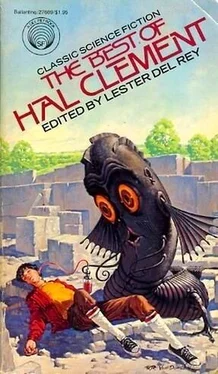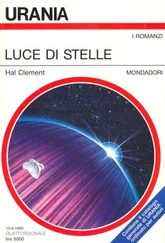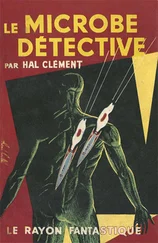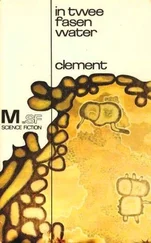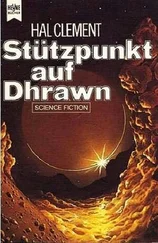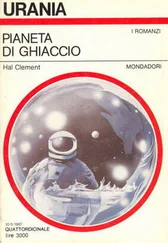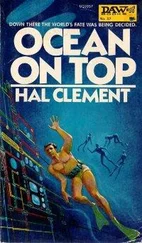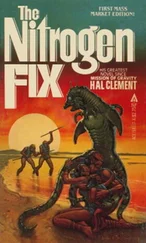Hal Clement - Answer
Здесь есть возможность читать онлайн «Hal Clement - Answer» весь текст электронной книги совершенно бесплатно (целиком полную версию без сокращений). В некоторых случаях можно слушать аудио, скачать через торрент в формате fb2 и присутствует краткое содержание. Год выпуска: 1979, Жанр: Фантастика и фэнтези, на английском языке. Описание произведения, (предисловие) а так же отзывы посетителей доступны на портале библиотеки ЛибКат.
- Название:Answer
- Автор:
- Жанр:
- Год:1979
- ISBN:нет данных
- Рейтинг книги:3 / 5. Голосов: 1
-
Избранное:Добавить в избранное
- Отзывы:
-
Ваша оценка:
- 60
- 1
- 2
- 3
- 4
- 5
Answer: краткое содержание, описание и аннотация
Предлагаем к чтению аннотацию, описание, краткое содержание или предисловие (зависит от того, что написал сам автор книги «Answer»). Если вы не нашли необходимую информацию о книге — напишите в комментариях, мы постараемся отыскать её.
Answer — читать онлайн бесплатно полную книгу (весь текст) целиком
Ниже представлен текст книги, разбитый по страницам. Система сохранения места последней прочитанной страницы, позволяет с удобством читать онлайн бесплатно книгу «Answer», без необходимости каждый раз заново искать на чём Вы остановились. Поставьте закладку, и сможете в любой момент перейти на страницу, на которой закончили чтение.
Интервал:
Закладка:
“I take it,” whispered Vainser in his reedy tones, “that if we fail to set up such a circuit, nothing will have been proved; but if we succeed, your science will be able to avoid for a few generations at least the sad fate of metaphysics. Your analogy of an electric circuit is probably the best possible, by the way, and we might as well continue to use it in thinking about this matter — provided we are careful to remember that it is only an analogy. It occurs to me also that, even if we do not succeed completely with Dr. Wren’s problem, we are almost certain to gain many helpful ideas in the matter of the computer itself. It works, Doctor, on a principle rather similar to thèconnectionism’ you mentioned first, though the ‘nerves’ are electron streams rather than material connections.”
“I agree,” stated Rudd. “The study appears to be both intrinsically worthwhile, and promising in the way of by-products. I hope you won’t mind my giving what help I can, at such times as my regular job spares me.”
“Not at all. The more people present who understand the computer, the better. I freely admit that I have no idea of the steps that must be taken to prepare my data for use. Perhaps if we went to examine it now — ” Wren’s voice trailed off into an interrogative silence. Vainser took up the conversation.
“I imagine your materials will not yet be in the office; the men have a good deal to do after a supply rocket arrives. I suggest we eat now — I do eat, in spite of appearances, Dr. Wren — and I am sure that all will be ready by the time we have finished.”
This suggestion met with approval, and after Wren’s first weightless meal, the three scientists betook themselves to the “office” in which the psychologist’s data had been placed. Vainser’s word was somewhat misleading; the place was more like a cross between a drafting room, a physical laboratory, and a photographic darkroom. The cases in which Wren’s material had been packed were moored to one wall and their airtight seals broken, though the lids were still latched to keep the contents from drifting too wildly. Wren, who had by now acquired considerable proficiency in weightless maneuvering, propelled himself over to the containers and began extracting numerous notebooks, sheafs of photographs, and not a few detached pieces of paper bearing what appeared to be hastily scribbled thoughts. These he transferred to the numerous tables, anchoring them with the spring clips which here replaced the magnetic paperweights to be found in most gravity-free desks. The other two made no attempt to assist, realizing that the material was being arranged in some order with which they were unfamiliar; but when the cases were empty, they accompanied Wren to one of the tables, where they were promptly delivered a surprisingly clear and well-illustrated lecture on general psychology. The illustrative material consisted partly of tabulated experimental data, partly of the schematic “circuit diagrams” with which psychologists like to illustrate things like conditioned and unconditioned reflexes, and very largely of some excellent drawings and microphotographs of nerve and brain structure. The initial explanatory lecture finished, Vainser took the initiative, and all three plunged into the task of so redesigning all these items that they could be presented to the “sense organs” of the giant computer.
These were varied in nature. Strictly numerical problems could be presented on punched tape or cards, as in many of the midtwentieth-century machines — though a shell-trajectory problem such as had taken those devices several hours could have been solved and the same answer-data tabulated in seconds by perhaps a dozen of the enormously complicated tubes of this installation.
In addition, the machine possessed eyes — lenses which focused on precisely divided sensitive grids, to which such items as graphs and wiring diagrams could be presented directly — if they were first drawn most carefully to the proper scale. Last, and least in the eyes of Vainser and his assistants in spite of its uniqueness, was the “ear” which permitted the actual dictation of data. The machine had a vocabulary of some six thousand words, which was constantly being increased by the spare-time labor of the technician who had developed the attachment. Ten tubes were able to integrate these words into the sentences of the English language; the machine could both hear and answer. Since this method did not permit the precision results of the others, the crew of the station considered it more an amusement than anything else; the work had been done quite unofficially, and on his own time, by a junior member of the staff. Whether or not it had practical value, it reflected on the entire device an aura of uncanniness that affected even Wren, when the attachment was demonstrated to him.
It was possible, he felt, that some use might later be made of this faculty, but Vainser and Rudd stated positively that the photoelectric analyzers were definitely needed for most of his data. This would entail the redrawing of all diagrams to an exact scale, in variously colored inks. Vainser promptly withdrew Rudd from his regular duties, in order to perform this task. Rudd shivered at the prospect, but set manfully to work. He comforted himself by remarking that the present diagrams were nothing to the ones they would get in the solutions, and they would be Wren’s headache. Vainser agreed, his toneless whisper suggesting amusement, as they worked.
The initial problem was more of a test than anything else. The data from an early conditioning experiment were diagrammed and fed to one of the eyes. The answer film bore a standard conditioned-reflex diagram. Wren was vastly pleased; Vainser and Rudd were satisfied, and promptly went to work on the records of a more complicated experiment. Only two of the thirty thousand-odd tubes in the computer had contributed to the first solution, and one of those acted solely in a “memory”
capacity; so it looked as though a great deal more could be done before any mechanical limits were reached.
The sun of success continued to shine throughout the first week. The three men worked, ate, slept, and periodically presented an accumulation of data to the eyes of the electronic entity that lay hidden in the walls about them. Conditioned reflexes and everything about them — inhibition, extinction, reconditioning; all that Wren considered important in that most elementary form of learning was fed to the machine, which in every case effortlessly designed a “circuit” capable of displaying the desired characteristics; and while some of the circuits were complicated enough, none approached in complexity even a minor ganglion of the human nervous system — not even the monstrosity that resulted when all the earlier answers were given to ten “eyes” simultaneously, for integration into a master “conditioning”
diagram.
“I’ve given a good many courses in psychology,” remarked Wren at one point, “but I’ve never before had a machine for a pupil. I must admit that it’s the best one I ever had — maybe it’s because I’m preparing my lectures more carefully than ever before!”
“Who’s preparing them?” queried Rudd, with marked accent on the interrogative.
“Well, I have a couple of very good lab assistants. If they will kindly resume assisting, we will now consider the problem of memorization, beginning with the experiments of Ebbinghaus.”
Work was continued. Most of the actual drafting of diagrams was done by Rudd, since Wren lacked the skill and Vainser the strength to handle the necessary tools. Ebbinghaus’ data were finished; with his work and that of his successors the field of memorization was gradually covered; and by bringing chemical as well as electromechanical reactions into consideration, a system was developed which, according to the computer, would account for the observed phenomena of human memory.
Читать дальшеИнтервал:
Закладка:
Похожие книги на «Answer»
Представляем Вашему вниманию похожие книги на «Answer» списком для выбора. Мы отобрали схожую по названию и смыслу литературу в надежде предоставить читателям больше вариантов отыскать новые, интересные, ещё непрочитанные произведения.
Обсуждение, отзывы о книге «Answer» и просто собственные мнения читателей. Оставьте ваши комментарии, напишите, что Вы думаете о произведении, его смысле или главных героях. Укажите что конкретно понравилось, а что нет, и почему Вы так считаете.
